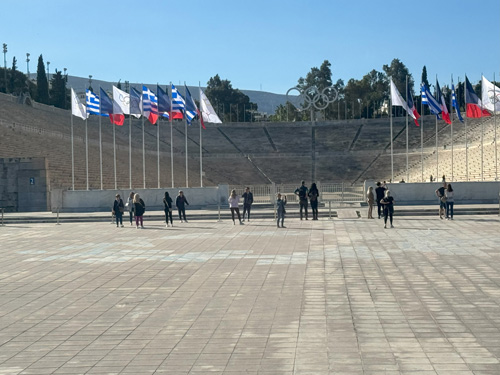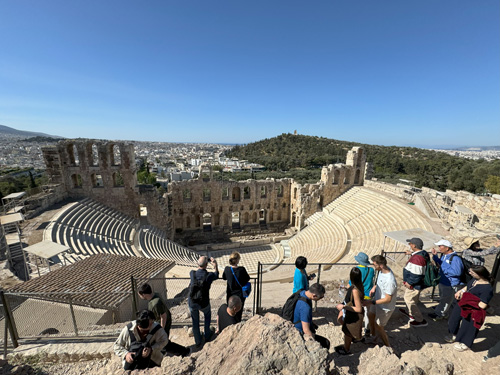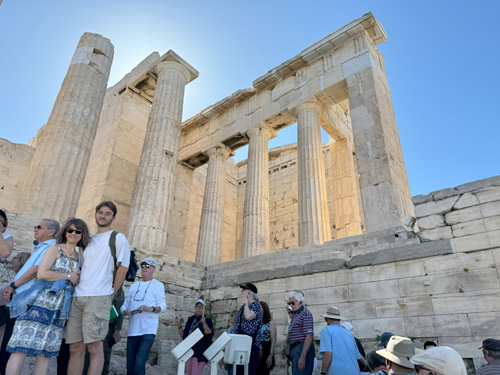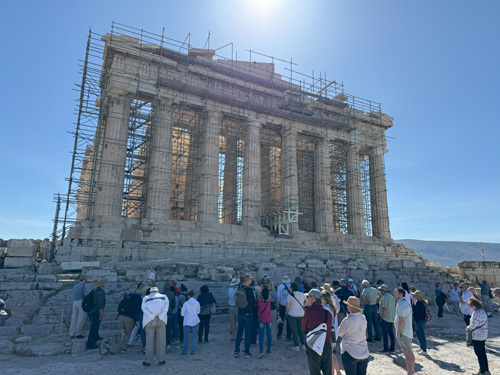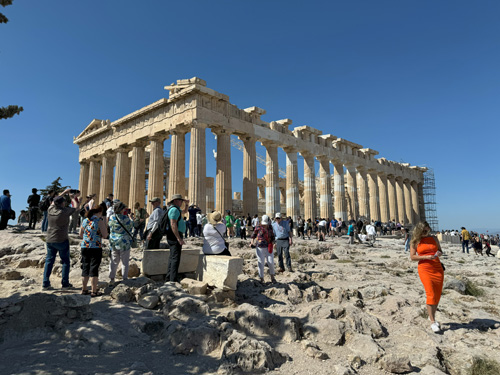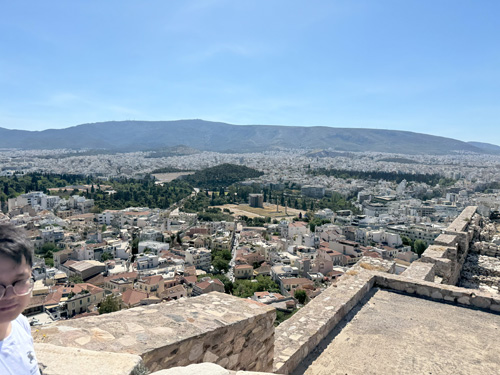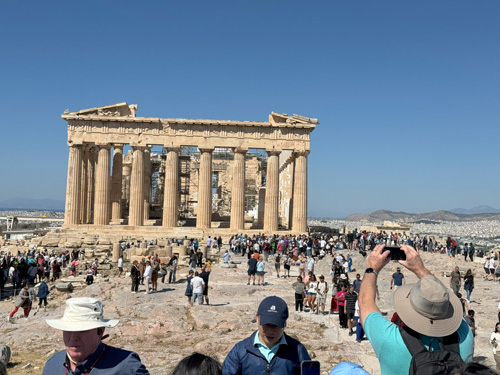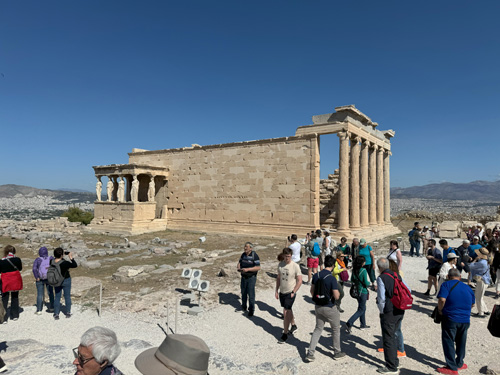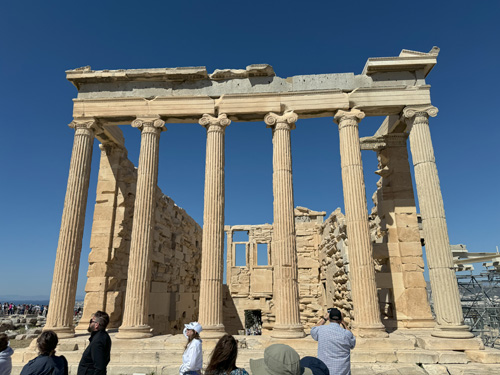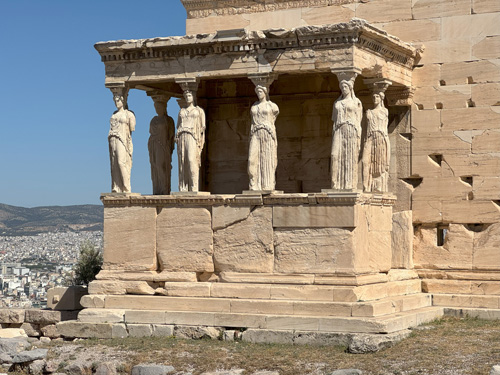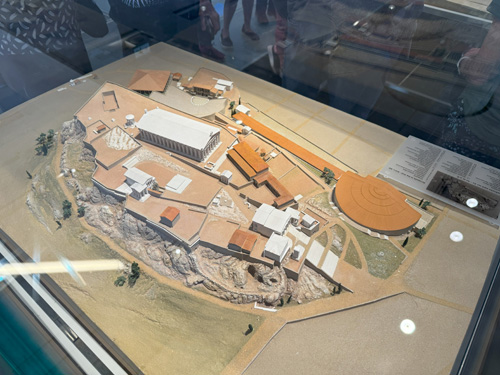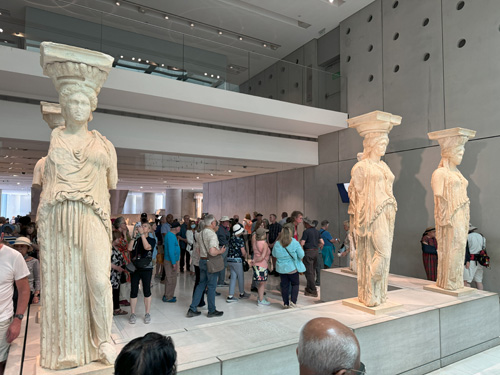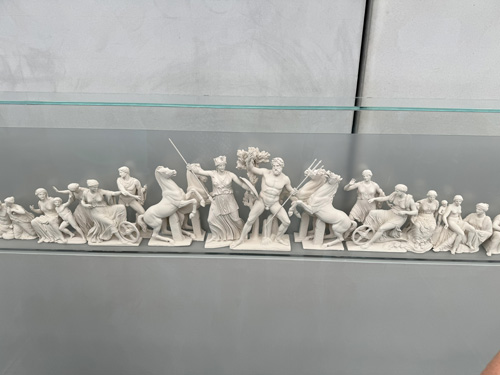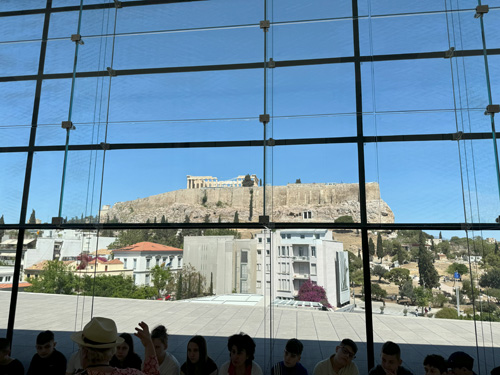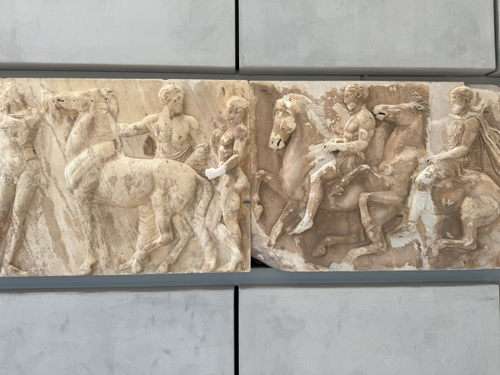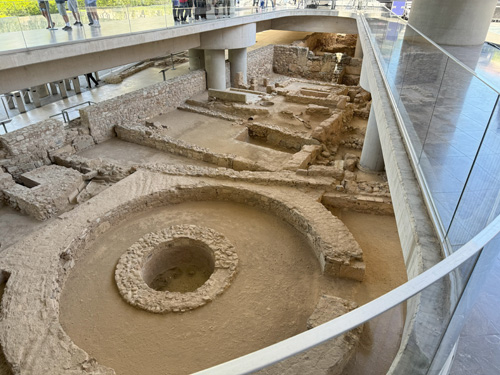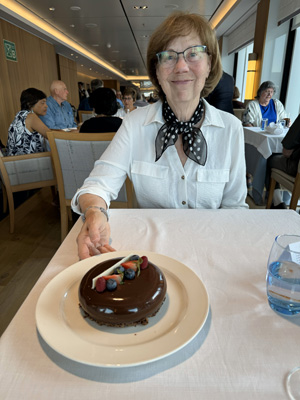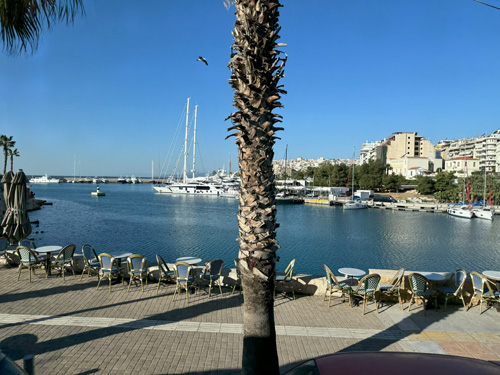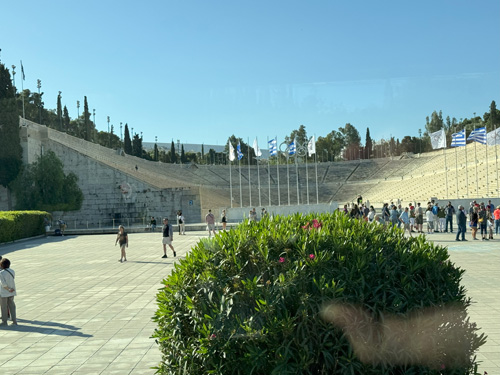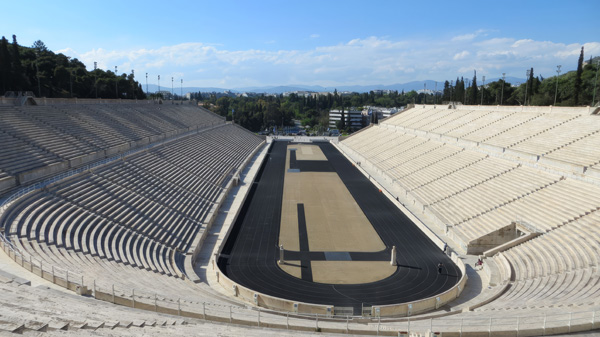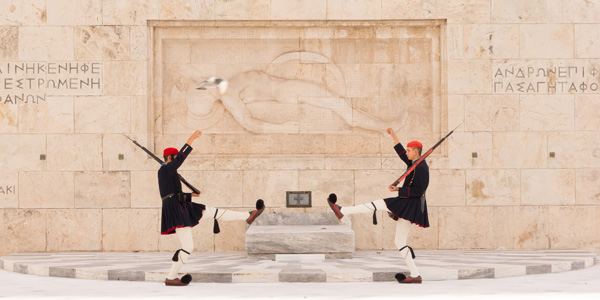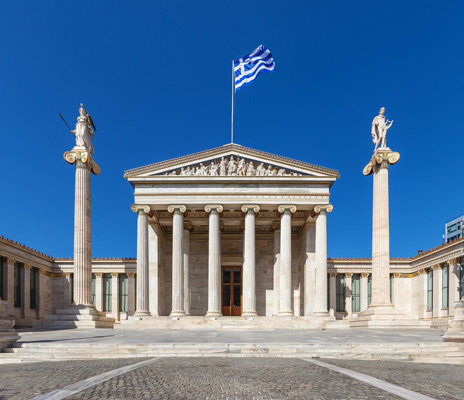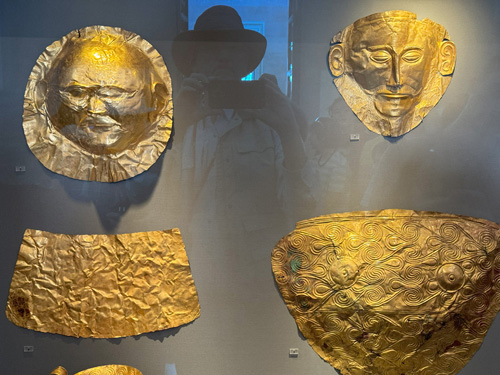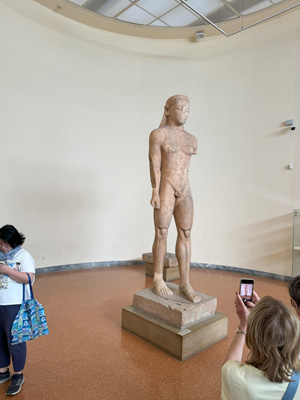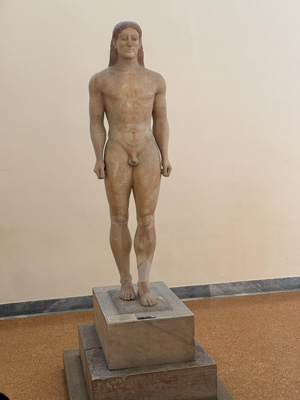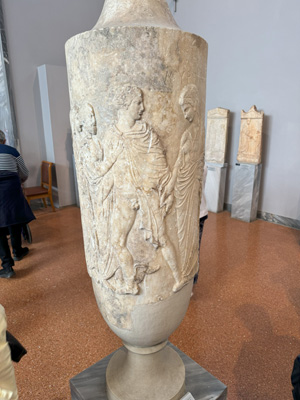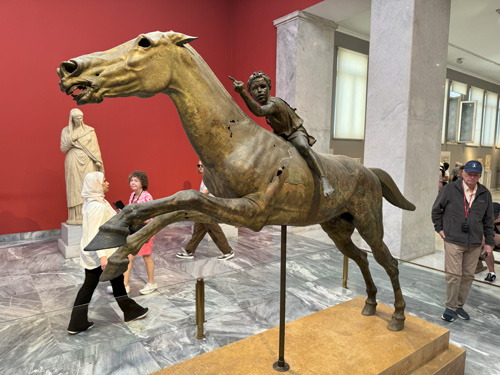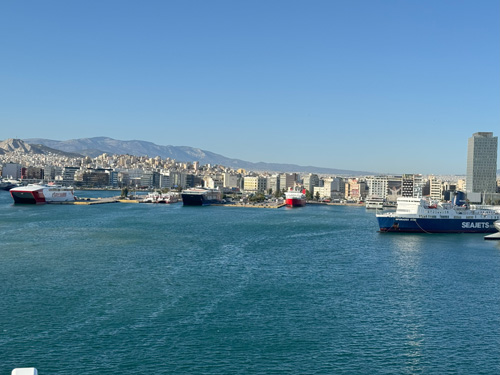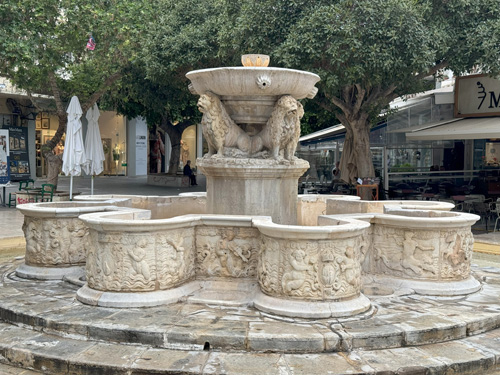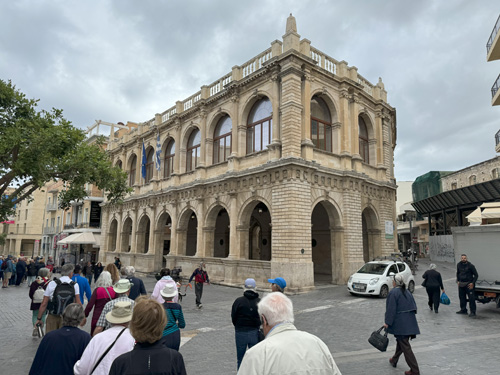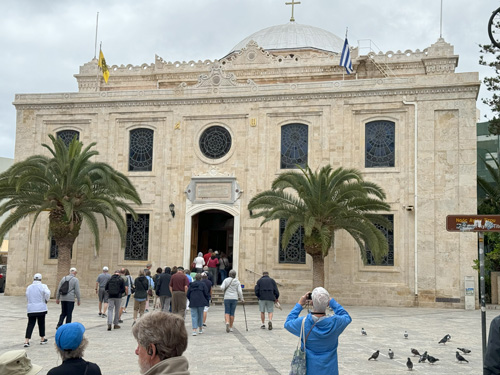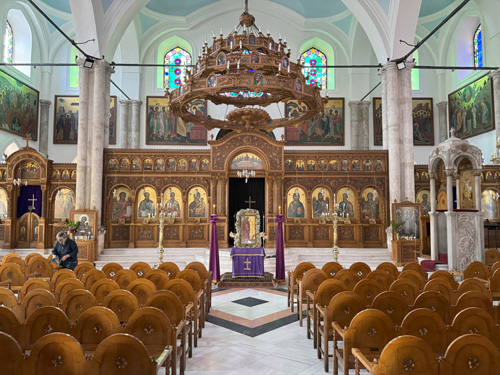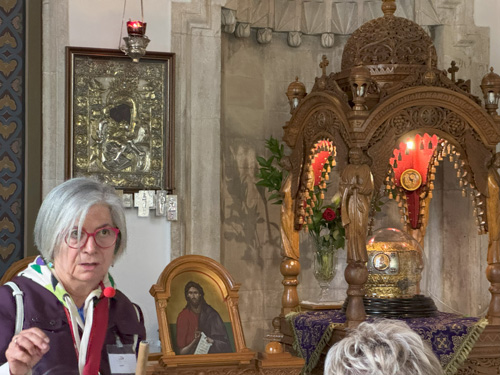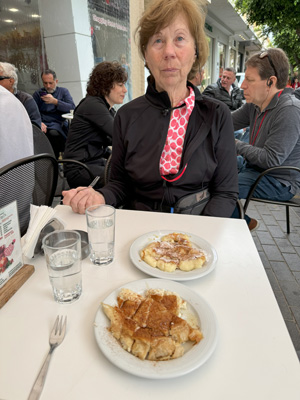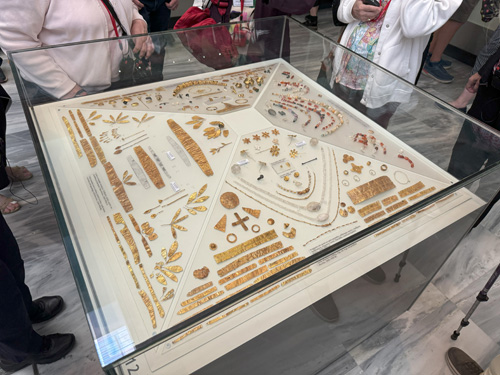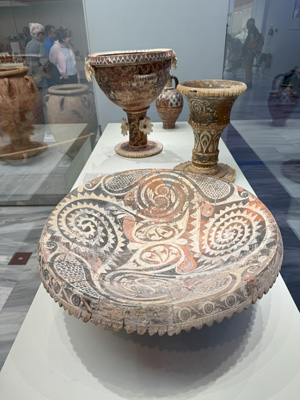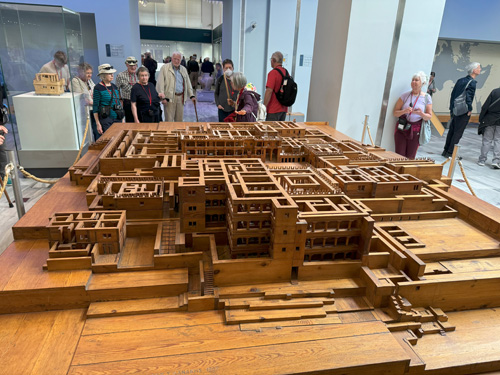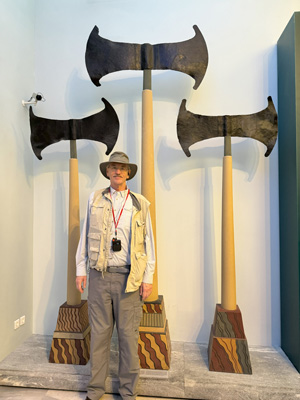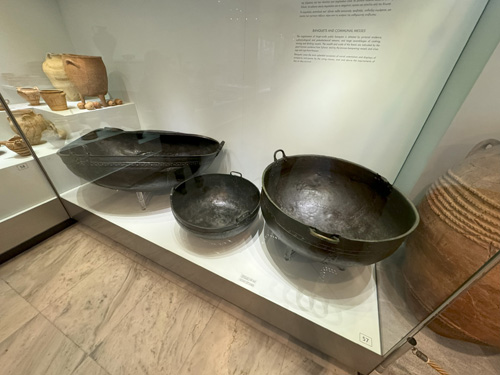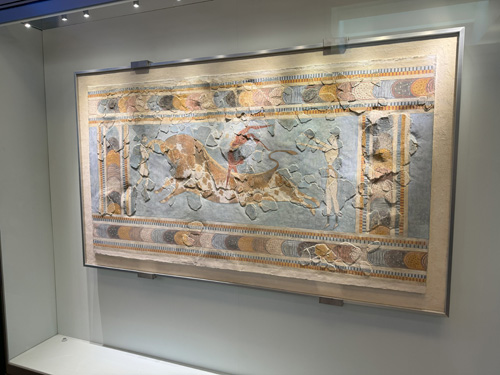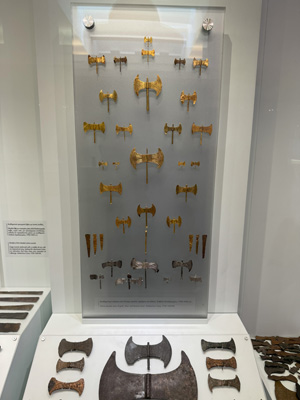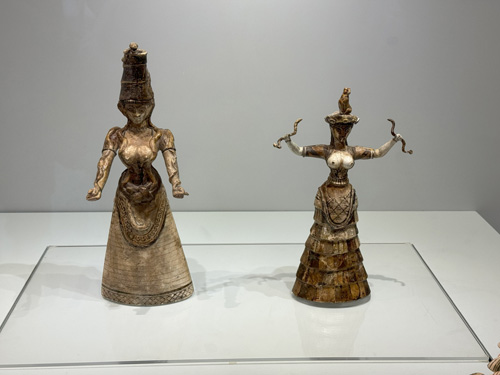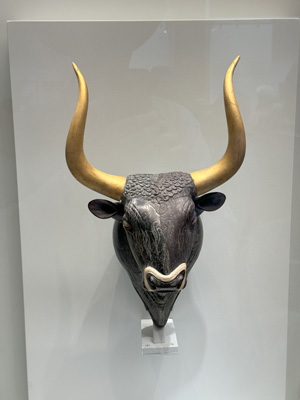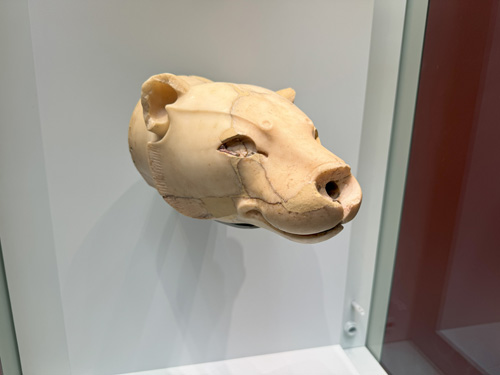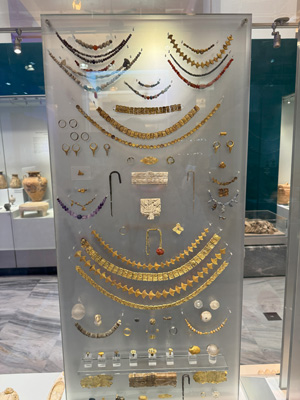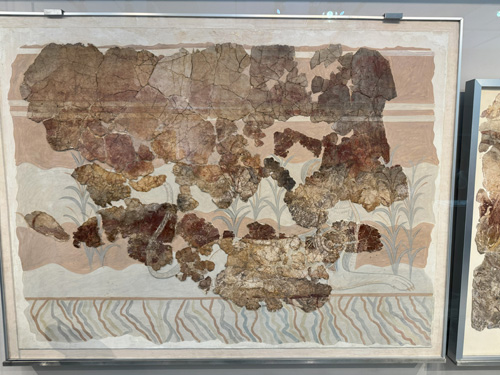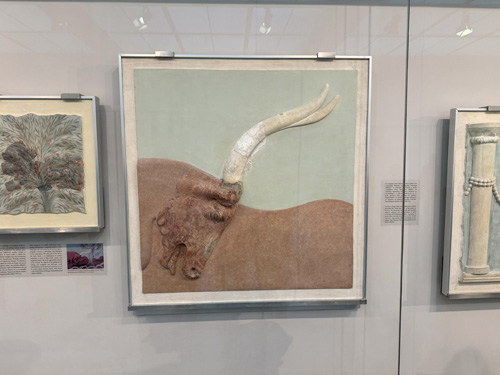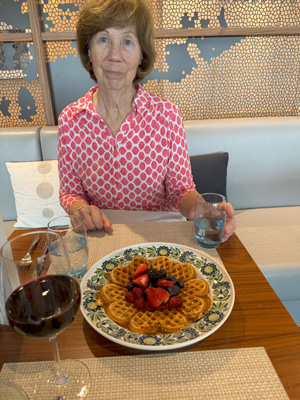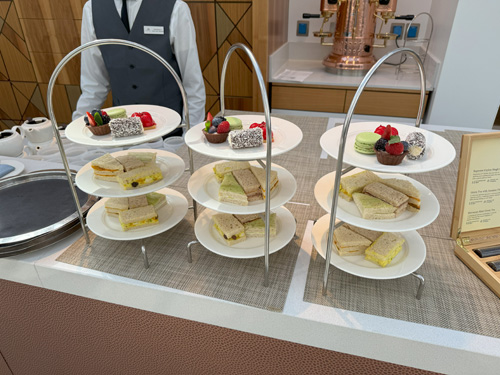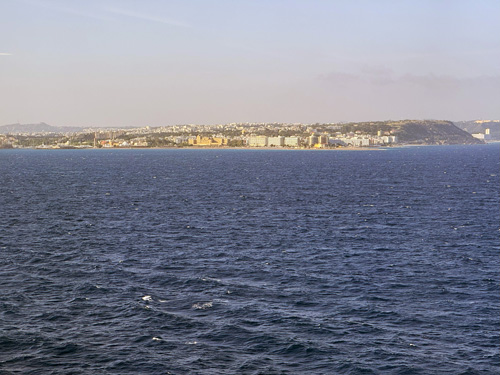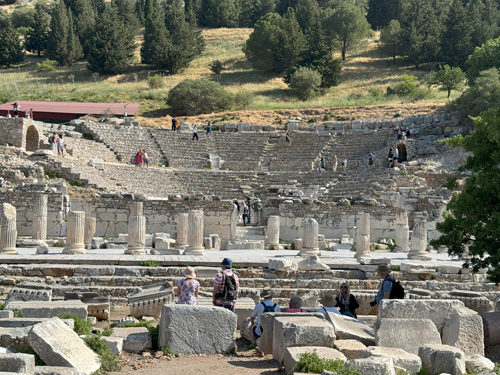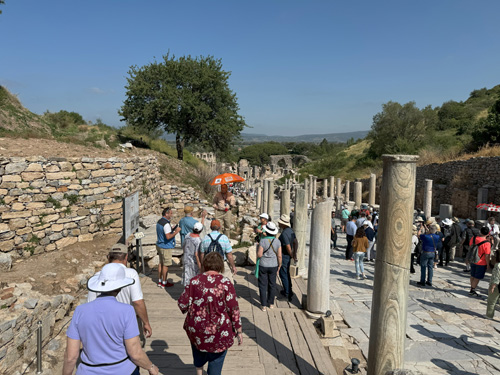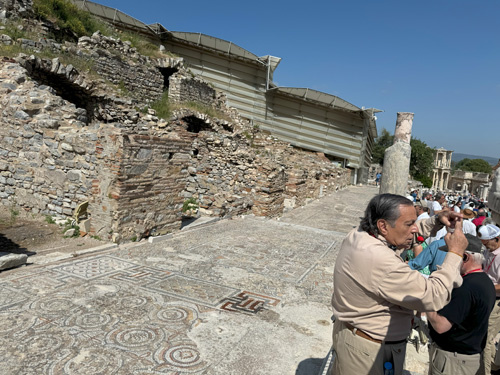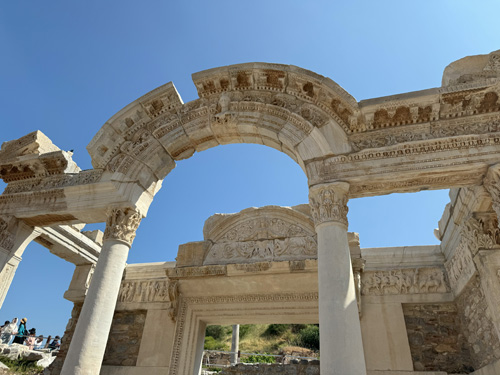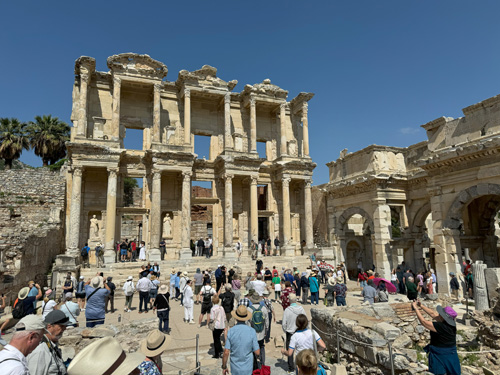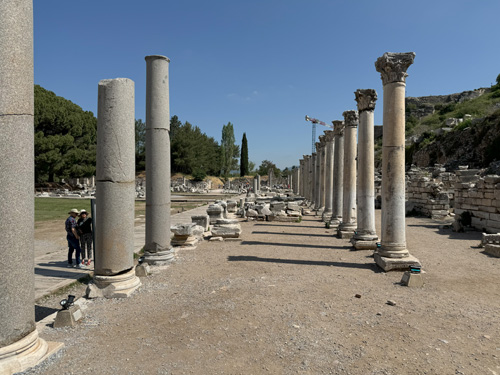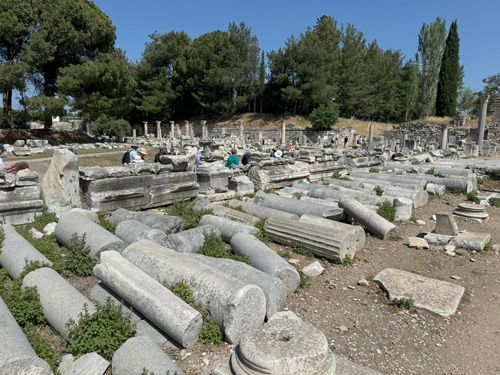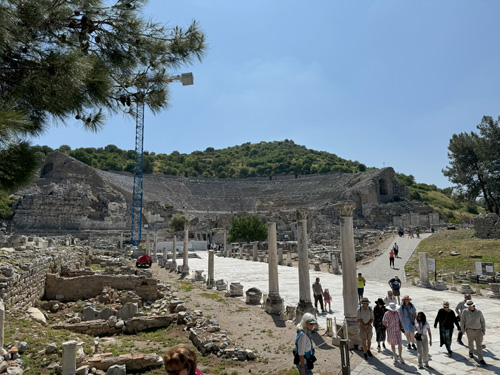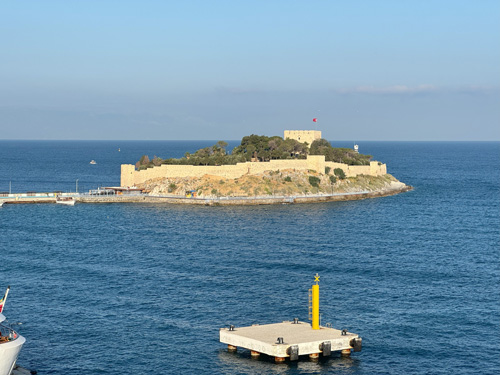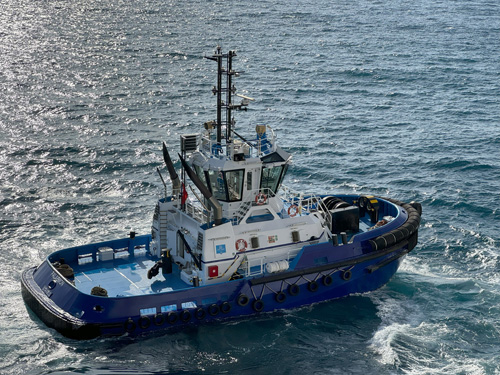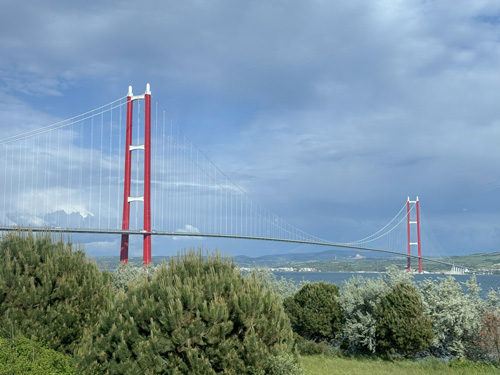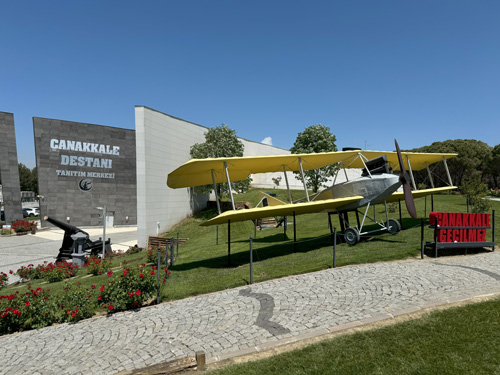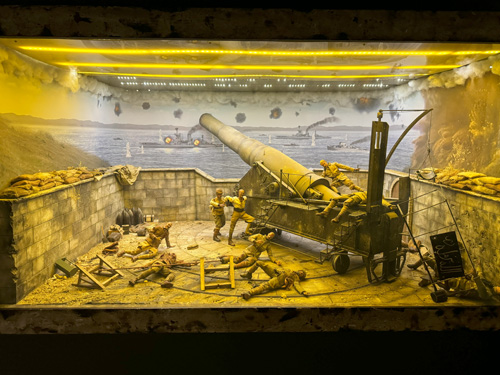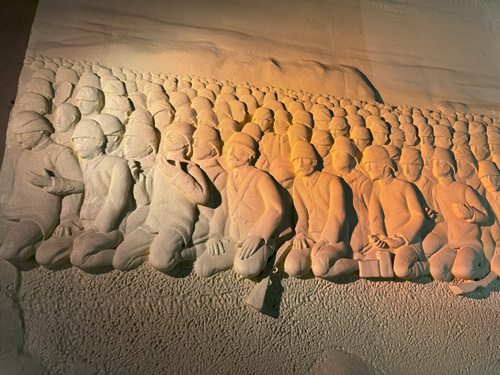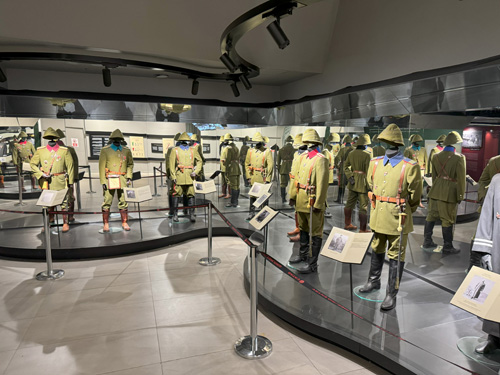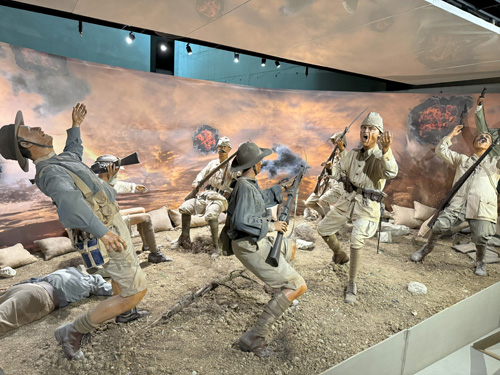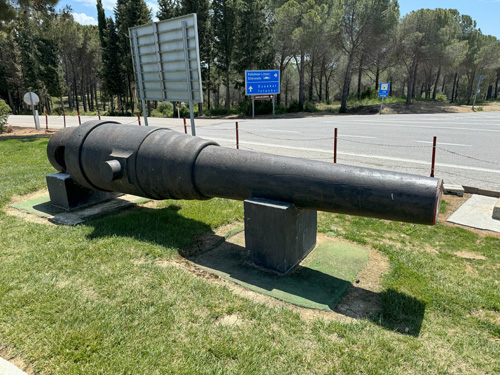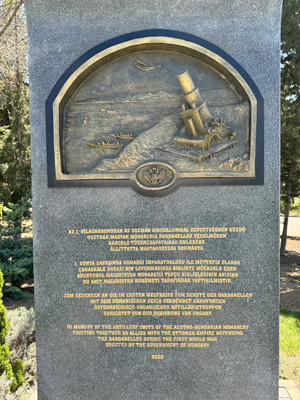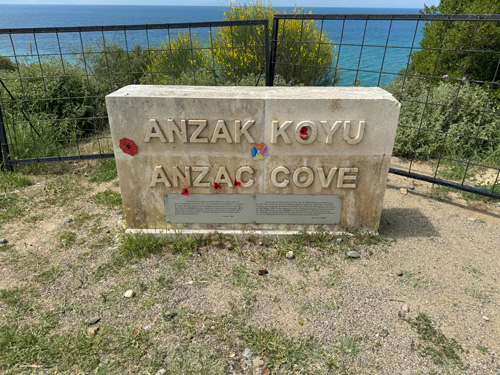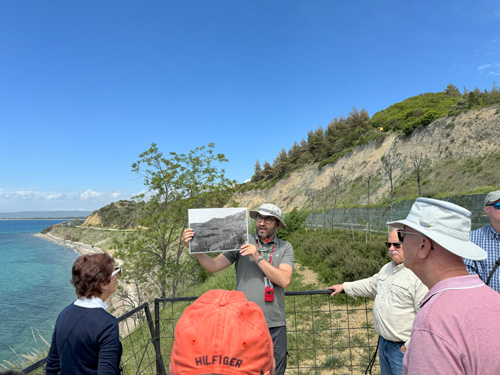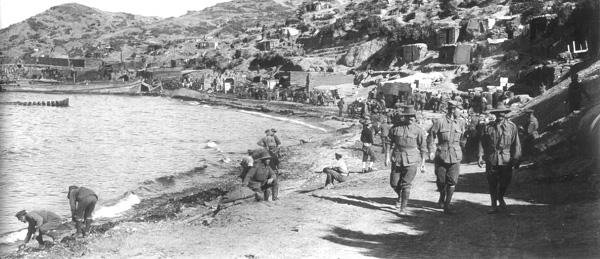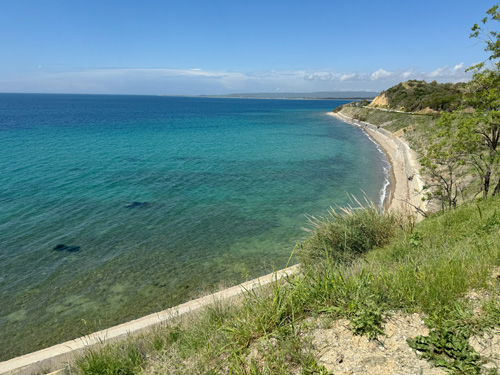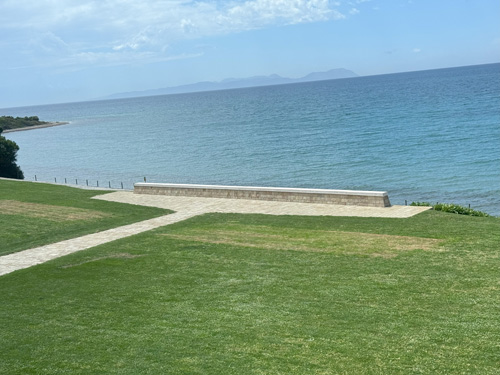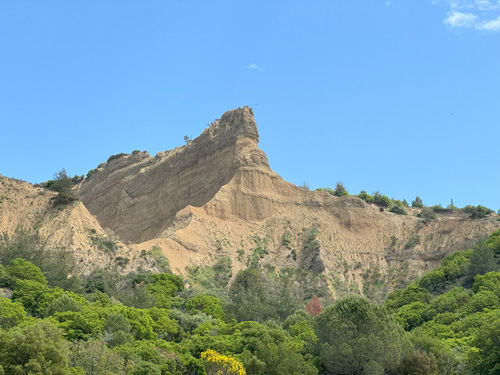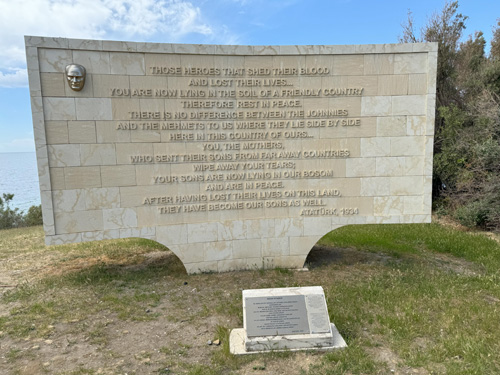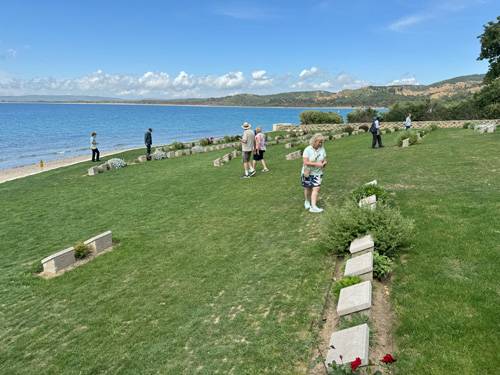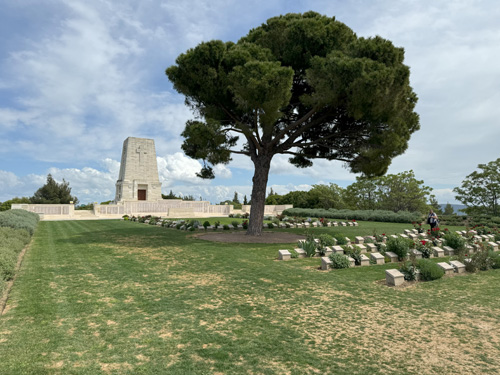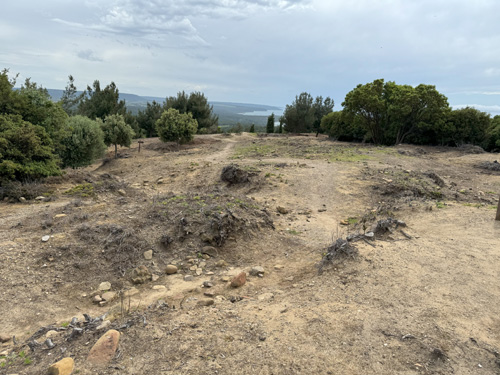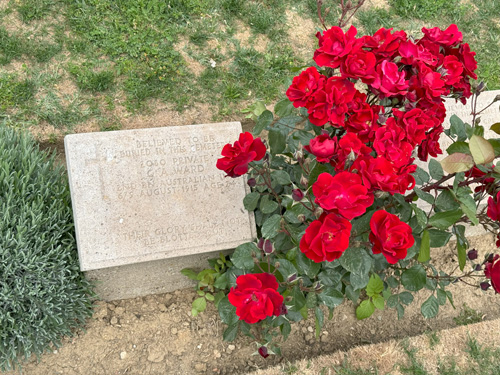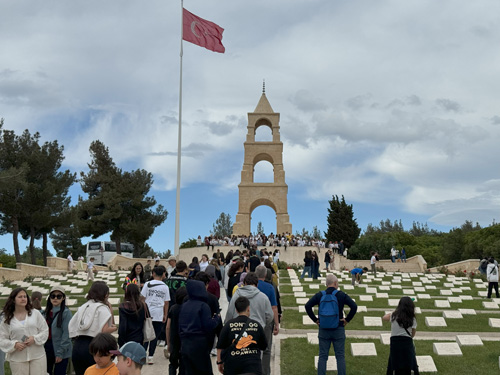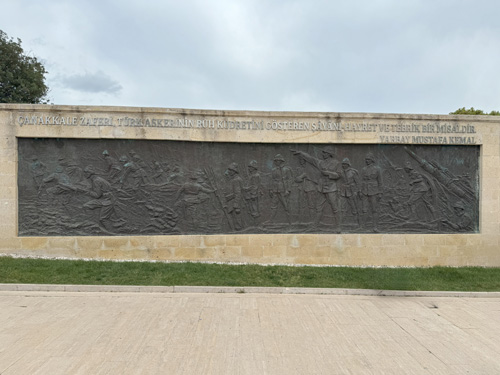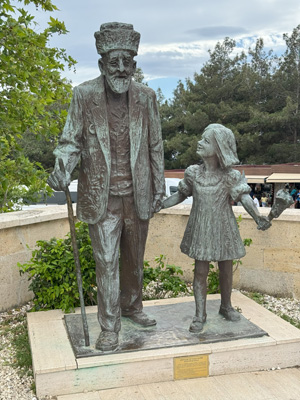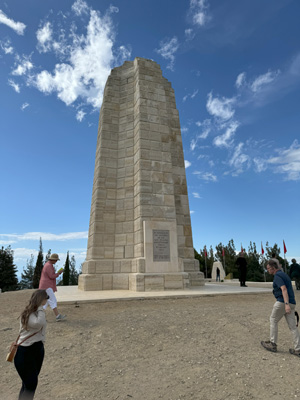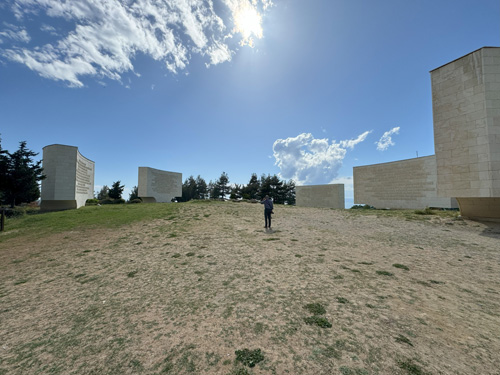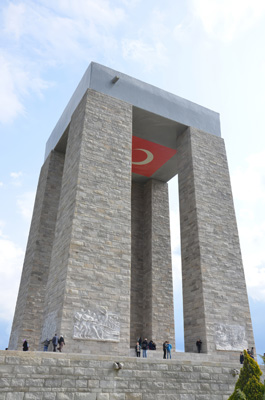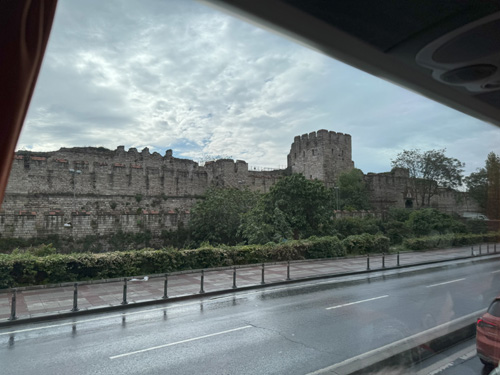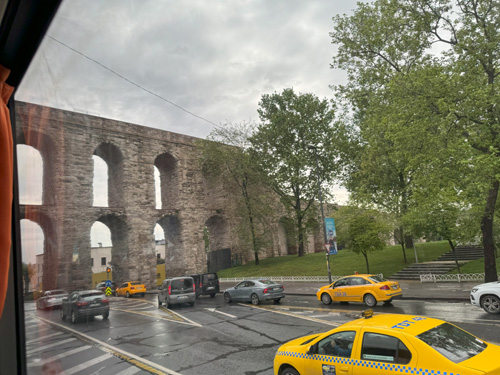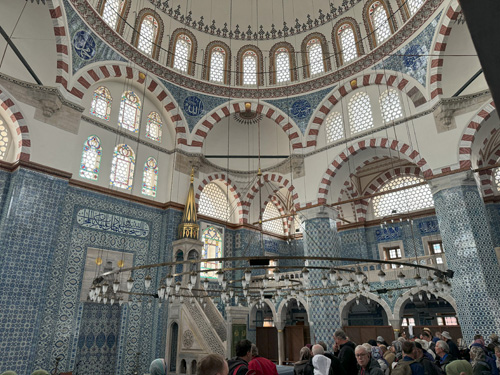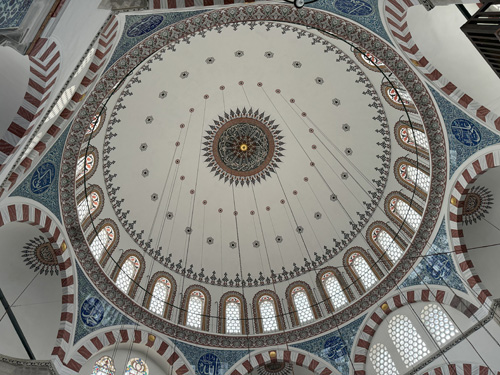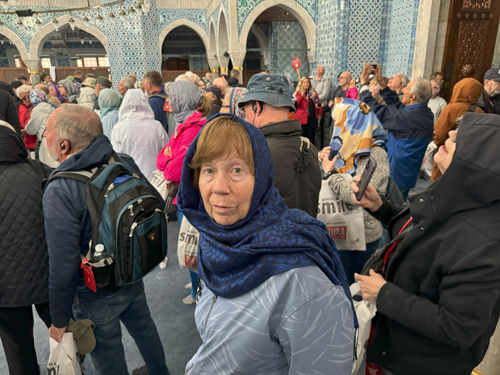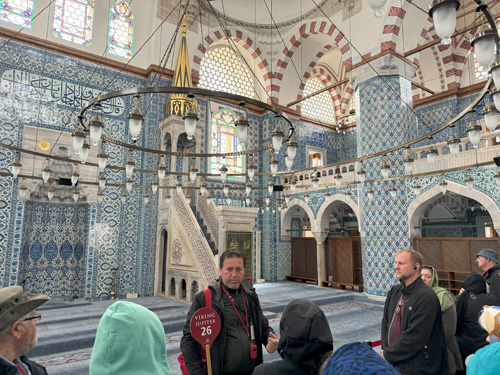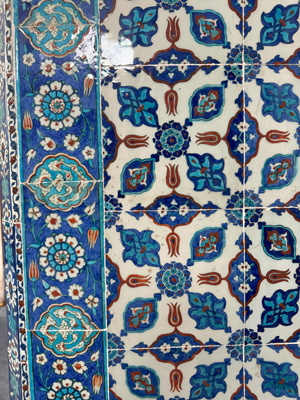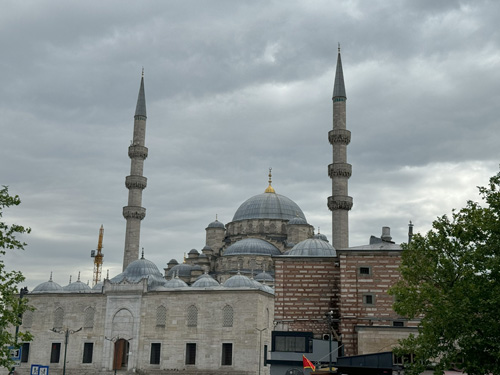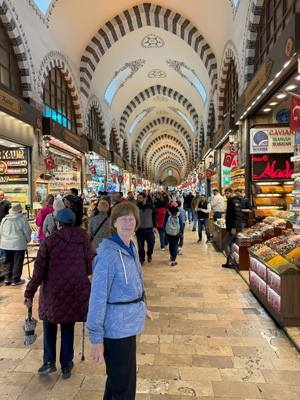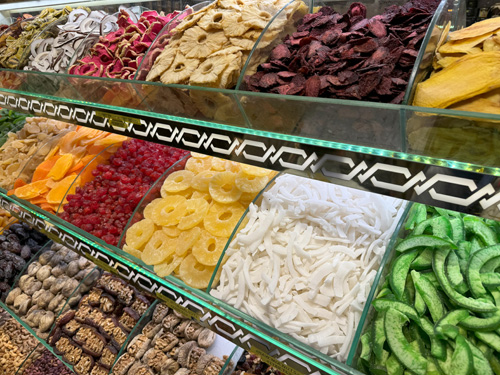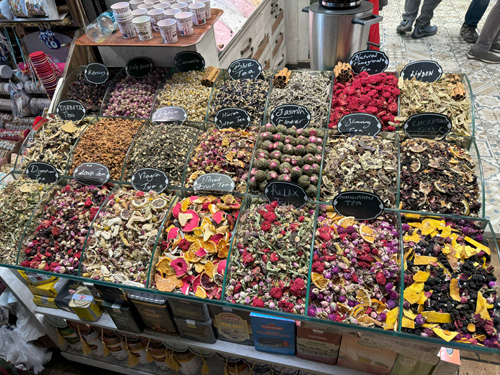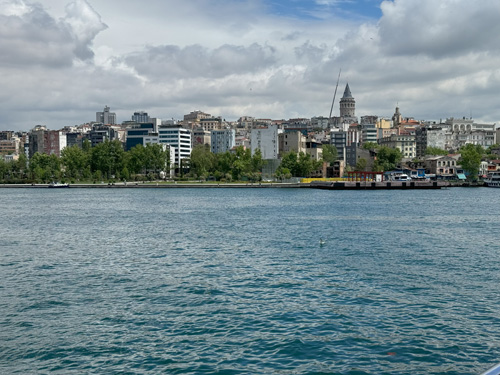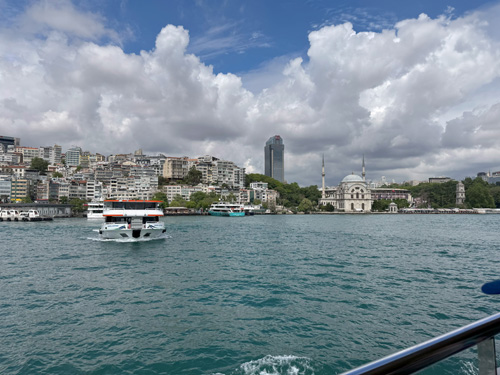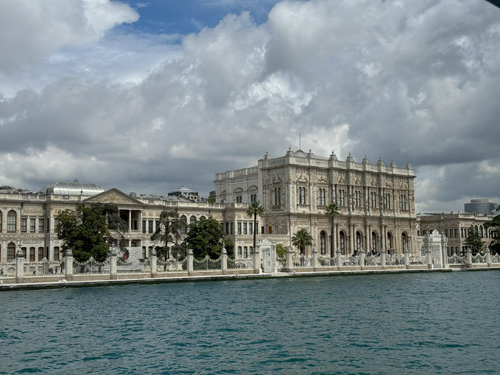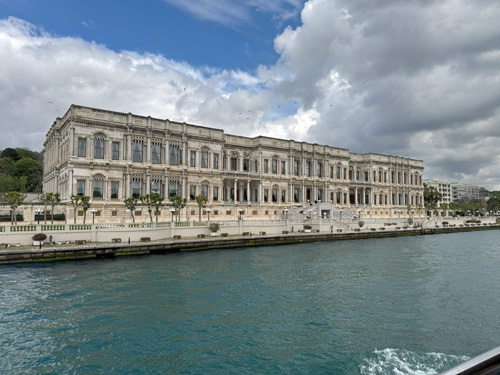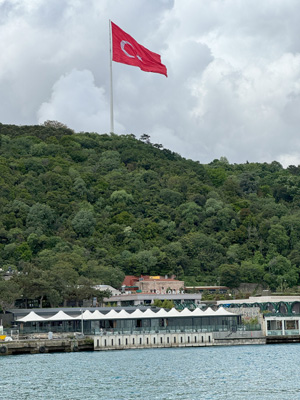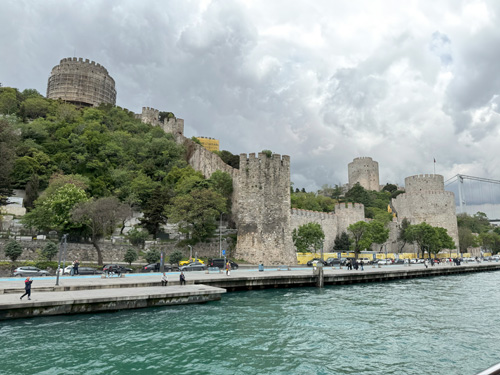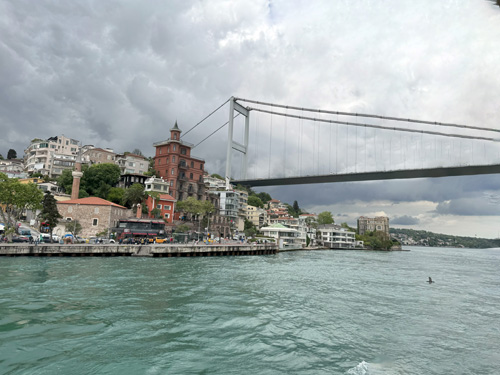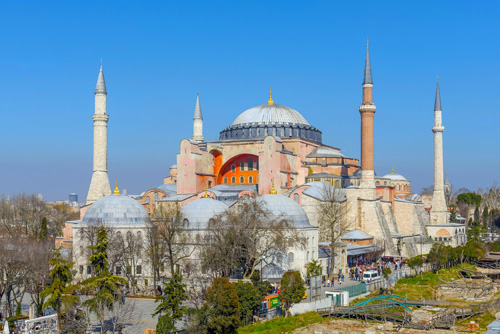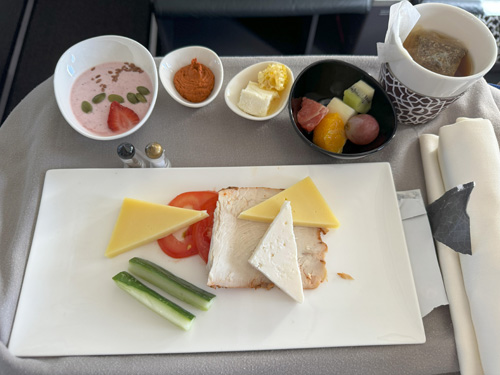Hal and Nancy’s Viking Mediterranean Cruise, May 2024
This my (Hal’s) report on Hal and Nancy’s brief visit to Rome and a 14-day Viking Mediterranean cruise from Venice to Istanbul, called “Ancient Adriatic Treasures.” Since this a long report, it is broken into two parts.
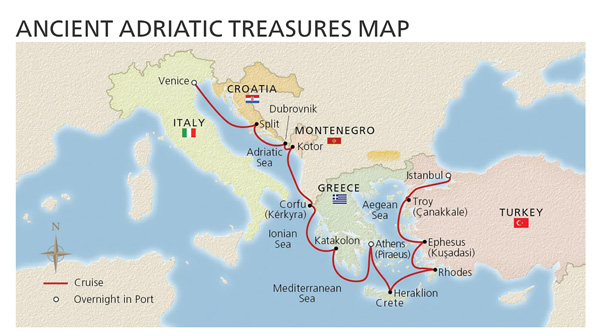
Sunday, April 28 — Athens
We docked in the port town of Piraeus (Peery-ass according to our guide), about a 15-minute drive from central Athens. I managed to lose my little notebook, so the following details will be slim. We took an excursion of the Full Acropolis Experience (not gratis because this disembarkation day for some guests had the same included tour we would be taking tomorrow). We bused around a few local sights and had some traffic delays because an organized foot race our guides were unaware of clogged some intersections. The Acropolis is a dramatically beautiful mesa towering over the city, home to a few temples and overlooking theaters and stadiums. Much of the citadel was built by Pericles in the fifth century BC. We walked up to the top, which our guide Kris said was 100 stair steps, but it was a very gradual slope and we didn’t count. Many are marble and uneven, which would be really unfortunate on a rainy day, but luckily today was absolutely beautiful—sunny, 70°, a little windy.
The main draw of course is the Parthenon, the temple to the virgin goddess Athena, from whom Athens takes its name. The western end is covered in scaffolding and heavy equipment is visible inside. We couldn’t enter it or any of the other temples. There was originally an 11.5 m statue of Athena by Phideius inside, but it was looted and lost. The crowds all over the Acropolis were almost suffocating, but we got good exterior looks and commentary from Kris, who was an excellent tour guide with college degrees in archaeology and history, humorous and knowledgeable. Other sites include the old temple to Athena, which is just foundation stones; the Erechtheion, dedicated to both Athena and Poseidon; the Propylaia, the dramatic entranceway to the complex; the Odeon of Herodes Atticus, and; the Theatre of Dionysos. And we got stupendous panoramic views of Athens stretching far into the distance.
We walked back down to the attractive touristy area called Plaka and visited the new Acropolis Museum, which is quite striking architecturally. It is built on an archaeological dig site, so rather covering it up, the building is on stilts with glass floors so you see the ruins below your feet. Even the upper floors are glass, so ladies in skirts incur a risk. There are many pieces recovered from the Acropolis of course, but there were two highlights for me. First, there are five of the six caryatids from the Erechtheion; the ones outside now are reproductions. There are only five because the Earl of Elgin removed the sixth and she is in the British Museum. The other highlight was the third floor, which has a beautiful view of the Parthenon and a display of all the sculptures that were at the top of temple, laid out in exactly the size and alignment of the building up above; many of these are just replicas of the Elgin Marbles, which Athens would love to have back.
At dinner Nancy received a very fancy decorated mousse cake for her birthday! We could only eat about a third and the staff delivered the rest to our cabin. I had the “destination menu” for dinner and it was moderately good Greek food. The evening show was a local folkloric group performing traditional Greek music, but it was very strange and we didn’t sit through the whole show.
Monday, April 29 — Athens
Another beautiful day. A bunch of new passengers came on board yesterday and, to my surprise, more arrived today. We took the included tour or Panoramic Athens and the Archaeological Museum. Our guide Yota was excellent and while driving she gave us lots of good info on the language, architecture, sports, mythology, and history. I came away with two Greek expressions: “neh” or “neh neh neh” is yes, “F. Harry Stowe” is thank you. She told us some others, but they immediately drained out of my brain. We drove past Zea Marina, which was once a major harbor, teeming with as many as 300 trireme warships. There was a second beautiful harbor nearby with mega-yachts, but I did not catch the name. We drove by Panathenaic Stadium, which was built in 144 AD, but was modernized for the first international Olympic Games in 1896. Seating 80,000 then, 40,000 today, it is the world’s only stadium built entirely of marble.
We passed the new Hellenic Parliament building and saw the soldiers known as Evzones dressed in 19th century uniforms guarding the tomb of the unknown soldier. The old Parliament House is now a history museum. And the Academy of Athens, a research institute. Except for some obviously historic structures, the architecture of Athens is relatively modern and not very interesting. The local law says that no building can be taller than the Acropolis, so there are no skyscrapers. Many of the buildings are rather drab and large areas of the city are covered with graffiti. We were told that during the financial crisis of a decade ago, over 300 days of protests and riots caused many fires and a lot of storefronts are still boarded up. I have included some Wikipedia photos below to substitute for my own moving-bus-window photos.
Our main stop of the day was the National Archaeological Museum, founded around the artifacts that Heinrich Schliemann unearthed in Mycenae in the 19th century. There are many gold items as well as vases and lots of statues (and pieces of statues). I would’ve probably found this uninteresting if not for the excellent narration of Yota. She described golden face masks and how clay tablets led to the recent understanding of Mycenae hieroglyphics; if they had not been hardened by accidental fires, they never would have survived from the second millennium BC. She led us through the progression of statues from prehistory to the first millennium AD, showing how style representations of men evolved into more realistic ones. Two of our favorite pieces were a bronze 450 BC statue of Poseidon (or perhaps it is Zeus—experts disagree) and a bronze horse from 140 BC, ridden by a young boy, the “Artemision Jockey.” It was found in a shipwreck in 1926. Bronze statues from antiquity are rare because they were frequently looted and melted down for other uses. There were a few statues of lions and I wondered about the source; Yota said that there were actually lions in Greece well before Christ.
On the return trip, we passed by the Temple of Zeus, which was completely covered with scaffolding, and Hadrian’s Arch. Roman emperor Hadrian was a lover of Athens and a great benefactor. At the Piraeus port terminal, we found a replica of the Poseidon statue facing our ship. The evening show was a British comedy magician and he was funny in a sarcastically droll way, but also quite expert in his relatively minor illusions.
Tuesday, April 30 — Heraklion, Crete
This morning is overcast but pleasant. Our included tour of Heraklion, the capital of Crete, was hosted by our guide Poppy, who grew up in the neighborhood we explored. Heraklion is named after the demigod Hercules. Our bus drove us past some really impressive city defensive walls and stopped in central Liberty Square. We took off on foot on the Daidalou pedestrian street, named for Daedalus, the mythical father of Icarus, who Poppy called the father of aviation. Ho-ho. We reached Lion Square, dominated by a large fountain adorned with lions, surrounded by cafés. We saw the 14th century Venetian-style town hall (the Loggia) and the 13th century Byzantine church, later a mosque and then a Catholic Church again, honoring St. Titus. The saint’s skull is housed inside a chapel. Poppy gave us a detailed explanation of christening and naming children. Outside was a street named for August 25, 1898, when the occupying Turks murdered a number of British citizens, which was the spark igniting the Cretan Revolt and the Greco-Turkish War. Crete was fortunate to be ruled by the Turks for only 200 years, versus 400 for mainland Greece.
We had a 30-minute break, so we took Poppy’s recommendation and had coffee and local pastries in Lion Square. The Greek coffee is strong and bitter. The pastries were called bougasta, one with a custard crème filling, the other with mizithra cheese and honey, both sprinkled with cinnamon. Delicious. Then to the Archaeological Museum, which specializes in Minoan artifacts, many 3000–5000 years old, and a lot from the nearby Knossos archaeological site (which we did not visit). Beautiful gold jewelry, pottery, religious items, wall paintings, and even some bronze items. I particularly liked the large wooden model of the Palace of Knossos (which if it were a more modern museum would probably be done in Legos). And a restored Minoan bulls-head drinking vessel from about 1500 BC. And the clay Phaistos Disc that has 241 Minoan symbols arranged in a spiral pattern. Some experts believe it is prayer, others a calendar, but no one has been able to translate the language used. Although the town of Heraklion is rather uninteresting, its museum is superb.
My only regret about Crete is that I wish we could have visited the western end of the island to see the main action of the costly German airborne invasion in 1941, such as Maleme Airfield. The Germans actually did attack at Heraklion, along with three other areas, but it was not their main focus and it was not successful.
Back on the ship I took advantage of the running track on deck 2, almost exactly one quarter mile long, to walk off some calories. The evening show was the ship’s vocal group doing songs from the 50s, 60s, and 70s. Some oddly anodyne selections. Avoiding controversy or copyright fees?
Wednesday, May 1 — Rhodes (Not!)
Although it’s a beautiful sunny morning in the Dodecanese Islands, the wind was 35 knots and Viking Jupiter was not able to dock safely in Rhodes—two attempts failed—so the captain announced that we would have to skip the port. We missed a walking tour of the town and the Palace of the Grand Master of the Knights of St. John. Too bad, because this was supposed to be one of the most interesting medieval towns in Europe, a UNESCO World Heritage Site.
The cruise staff scrambled to prepare for an unscheduled sea day, something not anticipated for our whole trip (unlike most cruises we’ve been on). They added a session about Voyager by the astronomy lecturer (whose previous frequent lectures were always scheduled during our meal times) and an afternoon movie, Grand Budapest Hotel, both of which we enjoyed. We attended the daily afternoon tea, which was excellent. (We didn’t previously because we didn’t want to spoil our dinner appetites, but tonight’s reservation is late … for us.) Our dinner was a repeat visit to Manfredi’s Italian. The evening show was once again the comedy magician.
Thursday, May 2 — Kuşadasi and Ephesus, Turkey
Kuşadasi (Koosh-a-dassa) is an attractive modern port city with lots of shops and restaurants. Our included tour bused us about 40 minutes to the ruins of Ephesus, the most important ancient Greek city in Anatolia (the Asian part of Turkey). It was founded in the 10th century BC, and a myth is that it was founded by Amazons and named for their queen, Ephesia. At the time it was a port city on the Aegean Sea, but river silting over the millennia leaves it a few miles inland now. Nearby was the fabled Temple of Artemis, another of the Seven Wonders of the Ancient World, but there is almost nothing left of the mighty building and we didn’t visit the site.
Our guide John, a retired architect, told us that we were actually visiting the third iteration of Ephesus, the one built by Alexander the Great in the 4th century BC. We started at the Magnesia Gate near the House of Mother Mary. (It’s unclear to me how Jesus’s mother ended up here, but some believe that the apostle John accompanied her here, where she subsequently died.) We observed an amphitheater called the Odeon, once roofed and seating 1400 for concerts, which was later used for political gatherings. Then we started descending a long street of large worn stones, Curetes St., lined with statues. John said that they were originally statues of Alexander’s young boyfriends, but later the Romans replaced them with famous politicians, poets, athletes, etc. John showed us some shops and the homes of rich people that he had been involved in excavating years ago. There are some very impressive mosaics on the sidewalk.
Next was the Temple of Hadrian, which was small and actually not dedicated to Hadrian, but built by Hadrian as a memorial to his 14-year-old boyfriend Antinous. (A lot of LGBT action back in those times.) It has four Corinthian columns and beautiful carvings on its arches. The most impressive ruin is of the Library of Celsus, built around 100 AD, which once held 12,000 scrolls, third largest in the ancient world behind Alexandria and Pergamon. It is named for Tiberius Julius Celsus Polemaeanus, senator and the proconsul for Asia, and his sarcophagus is beneath the library. We passed through the Agora, once hosting 110 shops, but now a long row of columns and hundreds of scattered marble pieces, awaiting restoration. (Excavations and restoration of the city started in 1863 and there are probably centuries of work left to do.)
Finally we passed the great Theater of Ephesus, seating 24,000. It is this figure that leads archaeologists to estimate Ephesus was inhabited by 240,000 people. St. Paul preached in this theater and was imprisoned on a hilltop nearby, where he wrote his letters to the Ephesians. We exited at Harbor Gate and witnessed the largest number of buses I have ever seen assembled, maneuvering excruciatingly to squeeze out of the narrow parking lot. There are three cruise ships in port today and this whole area was awash in crowds. Back in port, John urged us to visit a Turkish rug factory for demonstrations and sales, but we snuck back to the ship. We had to run a gauntlet of dozens of shops, each of which had a man approaching us about his wares. On the ship we enjoyed the beautiful weather and a great view of the port city, including Pigeon Island, which was fortified by the Genoese in the 13th century and expanded by the Ottomans to combat piracy.
The evening show was a video of a classical concert performance sponsored by Viking on their 20th anniversary featuring the UK National Symphony, which included a work specially commissioned for the cruise line. Quite beautiful.
Friday, May 3 — Çanakkele, Troy, and Gallipoli, Turkey
We sailed close to shore in the Dardanelles Strait and arrived in Çanakkele (Cha-NAK-el-ee according to the ship, Chana-KHAL-ee to a guide I had) before noon. I chose the World War I Gallipoli battlefield tour, but Nancy dislikes war topics and went on the included tour of Troy. My guide was named Abdurram, but told us to call him Apo. I was mildly surprised to see that the majority of folks on my bus were Aussies, but of course Gallipoli stands tall in their history. On the bus Apo described the run up to the campaign and the failed naval battle launched by Winston Churchill on March 18, 1915. The tour was originally destined to take a ferry across the Dardanelles, but Viking didn’t like the unpredictability of this service, so we drove 30 minutes north and crossed the brand new 1915 Çanakkele Bridge, which was constructed with a 2023 meter span, commemorating the 100th anniversary of the Turkish Republic. (The Turks refer to the Gallipoli Campaign as the Battle of Çanakkele, or Çanakkele Savaşi.)
Most of the peninsula south of the bridge is now a national historic park and is thus restricted from any development beyond farming. Quite picturesque. We passed by a couple of Turkish logistical ports—there were no roads here in 1915, so all supplies came by ship. We spent about 30 minutes in the Gallipoli War Museum in Eceabat, which actually wasn’t all that great. There were a few cool dioramas and a lot of Turkish uniforms, but little else. It’s a very nice building, though, and has a cool airplane out front.
On the western coast of the peninsula we passed by Brighton Beach and stopped at Anzac Cove, where 25,000 Aussies and Kiwis landed on April 25. (We never went to the landing areas used by the British at Cape Helles or Suvla Bay.) We had a great view of the beach as well as the mountain formation called The Sphinx (where Turkish snipers took out over 100 mean) and the hilly area called Lone Pine looming above. The invaders had quite a challenge scaling the heights toward the Turkish positions up steep slopes. Apo also described the Turkish assault of August 7–12. In this area is Ari Burnu Cemetery, housing 211 fallen. There is a large monument with very moving text, supposedly from a speech by Atatürk:
Those heroes that shed their blood and lost their lives ... You are now lying in the soil of a friendly country. Therefore rest in peace. There is no difference between the Johnnies and the Mehmets to us where they lie side by side here in this country of ours ... You, the mothers who sent their sons from faraway countries, wipe away your tears; your sons are now lying in our bosom and are in peace. After having lost their lives on this land they have become our sons as well.
Heading up into the hills above the beach, we passed the Respect to Mehmetçik Memorial, which commemorates an incident in which a Turkish soldier (mehmetçik is a nickname for soldiers, like GI) carried a wounded Australian officer back to his comrades and returned to his lines before fighting resumed. Then we stopped at Lone Pine Ridge, where there is a beautiful Commonwealth War Graves Commission cemetery, honoring 4988 dead. A number of the gravestones were inscribed with “their glory will not be blotted out,” which I thought was an odd way of expressing the sentiment. There are also remnants of Anzac trenches, which were sometimes only 10 meters from the Turkish lines. Nearby is an interesting pine tree. An Aussie soldier sent a pine cone back home and his mother planted a tree there. In 1990, the 75th anniversary, a descendant of that tree was planted here near the cemetery.
Next was Chunuk Bair, one of the three highest hills on the peninsula; we could see Hill 971, the highest, off in the distance. Here was a big monument to the 57th Turkish Regiment of the 19th Division, which was commanded by Col. Mustafa Kemal, later known as Atatürk, the founder of the Turkish Republic. Kemal had a famous quote here where he told his men, trying to resist a New Zealand advance on August 10, “I’m not ordering you to attack, I’m ordering you to die!” (In fact the Kiwis hesitated and this is essentially when the battle was won by the Turks.) There is also a big cemetery here with a monument to New Zealand. There is a statue honoring the oldest Turkish veteran of the battle, who died at age 108. And a giant statue of Kemal. It’s notable that the Commonwealth areas in Gallipoli are rather quiet, but the Turkish areas are mobbed with tourists buses and school children.
We did not visit the stupendous Çanakkele Martyrs Memorial. in fact, you could easily spend a day and half in this area, but we had a rather limited time because our ship did not arrive until noon. On the hour bus ride back, Apo talked about the Commonwealth retreat. We reached the ship 10 minutes before our scheduled departure.
Here’s Nancy’s description of her visit to Troy: to be provided
The entertainment this evening was a concert by Norwegian soprano Sissel Kyrkjebø, who happens to be the godmother of our ship. Lovely. And the ship’s vocalists performed selections from the Beatles Songbook.
Saturday, May 4 — Istanbul
We probably should have scheduled a more extensive stay in Istanbul to end our trip, but by now we’re a bit homesick and 17 days away is enough. It’s a huge city of almost 16 million, straddling two continents, so our included excursion of five hours hardly scratched the surface. We bused around a bit, moving from the port of Galata up the Golden Horn, and observed a lot of the city’s defensive walls, back when Constantinople was resisting the Ottomans. Some of walls are intact, other parts are blown out. At one point we drove underneath a giant ancient aqueduct.
We stopped at a mosque known as Rüstem Pasha, named after the Grand Vizier serving under Sultan Suleiman I, which is relatively small, but our guide said it was one of the most expensive in the city. It is known for its beautiful “Iznik” tiles in predominantly blue. Our guide told us quite a bit about Islamic practices, both formal and how they are in a modern city.
Next was an hour visit to a big spice market established in 1591, which is known as the Egyptian Market. We got taste tests of Turkish Delights and some pomegranate tea, and a hard sell for Iranian saffron. (The latter was rather interesting because it is dark red fibers, but when it is sprinkled into hot water, it turns the familiar yellow.) The market is extremely colorful. It’s a wonder to us how dozens and dozens of merchants selling essentially the same thing can profit side-by-side.
Finally we took a 90-minute boat ride on the Bosporus, which was neat because we could see two continents in one glance. We passed lots of high-end hotels on the waterfront, the palace of Dolmabahçe Sarayi, and the impressive fortress called Rumelihisari. We passed under the two massive suspension bridges connecting the continents. I thought the European side was much more interesting than the Asian. Both were quite hilly and the numerous buildings clinging to the sides were reminiscent of Sausalito. Along the way we were in the middle of a big sailboat race and saw three dolphins swimming together. Along the way we passed two famous landmarks that I couldn't see well: Hagia Sophia Grand Mosque and Topkapi Palace. The tour boat deposited us back at the cruise terminal, which is very sleek and modern and incorporates a large shopping center.
The entertainment tonight was a folkloric show involving whirling dervishes, but we skipped it to pack and get an early night’s sleep.
Sunday, May 5 — Flying Home
We arranged airport transportation with Viking and for an 8 am flight they had us meet for the bus at 3:30 am. Some passengers were told to meet at 1:30! They had a small continental breakfast for us and the ride to the airport was about 45 minutes. The Istanbul airport is extremely modern and immense—15 million square feet! For comparison, the U.S. Pentagon is 6 million. There are dozens and dozens of beautiful stores and large restaurants. The business lounge is probably four times the size of ones I have visited in other airports, with bounteous food options. Of course, this immensity means a lot of walking. One odd thing is that they scan you and your luggage at the entrance to the terminal and again on the way to the gate.
We flew Turkish Airlines on a United ticket to Frankfurt and were pleased with the comfort and service of their A330 business class. Quite decent WiFi was free. Breakfast was a bountiful multi course meal; too much, really. After a three hour layover in the Lufthansa Senator Lounge, we flew regular United (comfortable 777) back to San Francisco.
We had an excellent trip in Rome and with Viking, marred only by various minor illnesses along the way. We will definitely travel with Viking again. This December we will experience their river longships for Christmas markets on the Rhine.
